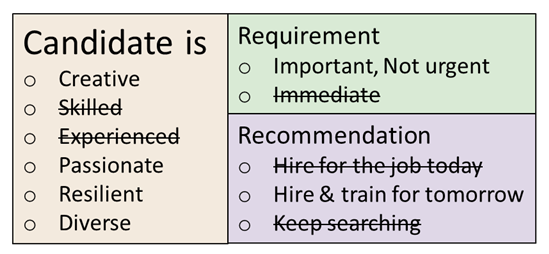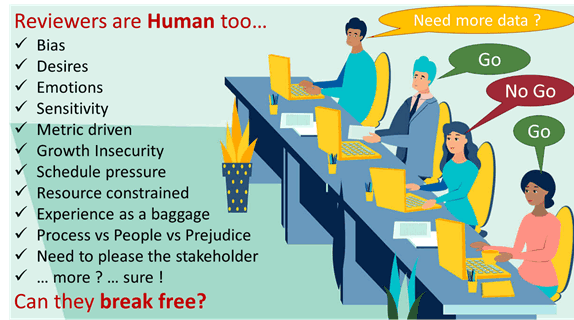Posts
NDE 4.0 Ethics Panel – Roundtable Discussion with NDE 4.0 Influencers | Episode 11
– Ripi Singh, Tracie Clifford, Matt Litschewski
In this episode of the NDE 4.0 Podcast, we have an exciting new panel format in which we chat with NDE 4.0 influencers and leaders and discuss the future and what an NDE 4.0 Ethics Code would look like. In this discussion, hear from three experts who are leading the way in NDE 4.0 innovation, education, and coaching.
Request a NDE 4.0 Workshop
Join the conversation on LinkedIn
Just One Skill That Matters?

There is only one skill that matters.
Really? It is the skill to develop new skills all the time, quickly.
Will industry 4.0 kill our jobs?
This is the most popular question in our panel discussions on this topic. My response is usually as follows.
“History has proven that all previous revolutions have created new higher-paying jobs, reduced the number of working hours, improved productivity and prosperity. People who were worried about jobs, and companies that were slow to adapt to the change paid the big price. We have come down from a 7-day workweek before the first industrial revolution to 5-days. I can foresee a 4-day workweek by the time we are all digitally transformed.”
… pause…
“I have lived through the 3rd revolution. My freshman engineering was using log tables, I got a calculator in Sophomore, and saw the first computer as a senior in 1985. When computers came to India, we had serious nationwide social protests, against the Prime Minister’s move to bring the technology. It was perceived as a job-killer. Most of my friends and their parents disliked my excitement with the toys. Our college took a student account at the very first computer center in the city and each one of us was given 5 minutes of CPU time on the Digital Equipment Corporation (DEC)’s PDP-10 mainframe. My allocated 5 minutes were used up within a week and then I borrowed minutes from those who were busy protesting against the computers. Today the whole economy of the country (India) and many other nations is because of the IT skills.”
… pause …
“You see, it is not a jobs question. It is a competency question. Your skills will go obsolete. You need to reskill, you need to retool, you need to relearn. To confidently try new things and new ways of doing something is the most important trait. So, don’t worry about the jobs. There will be plenty more. Worry about developing the competencies and knowledge for the jobs that will be available.”
Traditional trade skills will have to embrace the entry of new skills – some multidisciplinary blend of Digitalization, Automation, Data Scientists, Machine Learning, Machine Communication, Man-Machine interface, Additive Manufacturing, and new ones every few years. The role of data scientists is already picking up. These are specialists who will extract and prepare data, conduct advanced analysis, and apply their findings to improve products or production.
Traditional soft skills will have a higher focus on complex problem solving (identification), creativity, open mind, critical thinking, teamwork and transparency, decision making under uncertainty, robotics supervision, and more. I can see a role for a full-time Fictioneer, Ideation facilitator, Concept artist, …
Job Descriptions are dying
If you can describe your job in sufficient detail, it will soon be replaced by a robot. You need to focus on talent that can bring intellectual capability and adaptability to meet Job Expectations. Simple tasks are being taken over by robots and shop floors are getting digital. Humans now need to oversee humans and cobots together. Perhaps we will see robots supervising other robots and then humans, sooner than we think. And let us add artificial intelligence or intelligence augmentation to the mix. We now have a whole new set of challenges with talent management.
If you consider the scope of digital skills required, universities will have a difficult time adjusting. In one of my recent conversations with a University Dean, I asked him how they will adapt when their curriculum revision cycle is 3-year, because very soon the content obsolescence period will be shorter than three years. I think Industry will take charge and not rely on university degree programs.
Focus is also shifting from graduate-level college degrees to rapid certification and creating relevant competency just in time and in place. Augmented reality-based training or job instructions might further diminish the value of formal classroom trainings. From an industry perspective, HR may not be able to handle the retraining, because of scope and content. Chief Technology Officer (CTO) may have to take this one on. There will be room for new types of colleges and academies to develop talent for the digital requirements.
Creativity can be learned, it is a practiced art. A whole library of how-to books has already been written on the theme. Some of the books are better than others, but they all focus on a couple of central ideas: be open to new things, ask questions, doodle around, and create ‘firsts.’
According to the BCG[1] employees will need to shift their focus to the things machines so far can’t do, will have to be more open to change, possess greater flexibility to adapt to new roles and working environments, and become accustomed to continuous interdisciplinary learning.
The global pandemic is demonstrating the need for resiliency skills. Businesses surviving in 2020s will be those where the organizations are flexible, adaptive, and agile; constantly analyzing and adjusting. Employers might look for such skills as a requirement in the near future. These skills are not easy to teach or learn.
In Summary,
To pick up a new skill on demand is the most important skill.
Ability to do the job that cannot be described clearly, is what will keep you in the job.
If you like this blog post, you will like my book – “Inspiring Next Innovation Mindset” available on Amazon.
If you wish to engage with me in a conversation, on important innovation topic, please register for our monthly sessions at www.inspiringnext.com/events
[1] Man and Machine in Industry 4.0; M Lorenz, R Strack, K Lueth, & M Bolle; BCG Report; https://www.bcg.com/publications/2015/technology-business-transformation-engineered-products-infrastructure-man-machine-industry-4.aspx ; Sept 28, 2015.
Managing Risk in an Innovation Project – Part 2

Can you see the role of human factors in a gate review?
Really? In spite of a well-defined stage-gate process for managing innovation, projects that deserve to be discontinued (fail-fast) pass through the gates and fail-late, causing huge losses and sometimes the entire business. After all gate-keepers are human, and subject to emotional interference.
Suggest reading part-1 at Managing Risk in an Innovation Project
What Makes a Stage-Gate Process Interesting?
Like any organizational system, the gated process does not always work as intended. It is a highly emotional event, irrespective of objectivity designed in the process. Let us look at some of the issues that make it interesting.
Applicability
One must ask a question if a given project is right for stage-gate process or not? Sethi and Iqbal[1] argue that Stage-Gate controls have the potential of restricting learning in a new product development project and thus hurting the performance of novel new products. They specifically observed through data, that control on new product development exercised through rigorous gate review criteria, increases project inflexibility, which in turn leads to increased failure to learn.
Success Metrics
Sometimes, the management chooses a metric around increasing the first pass yield of gated reviews. That is not a good practice. It drives many wrong behaviors: (a) a tendency to pick low-risk ideas/projects to begin with, (b) to keep working to perfection, and (c) the review team’s bias towards a ‘GO’ outcome. That is all counter to innovation and the purpose of a gated review. You want to fail fast and learn fast. It is OK to track, but do not set a goal for yield.
Schedule pressure creates a tendency at compromise marginal situations, sometimes take decision with insufficient data or under-estimate the risk. And if there is a sense of urgency or a need to meet a certain specific performance metric, the entire interpretation of the data gets skewed.
Human Bias
Decision making at the gate review gets effected by bias from various directions. The reviewers can get emotionally vested with the idea and progress based on watching it evolve with their input at previous gates. Experience creates an anchor bias to previous success stories and traditional ways of doing things. Trying to keep the big boss happy, can sway decisions in one direction. Opinions of certain well recognized individuals carries more weight than data-based evidence.
Individual biases also play a role in team dynamics, if the review team chair is not able to handle conflict.
Delicate Engagement
Continuous engagement of review team with the project, even when limited to reviews, leads to a 2-way entanglement. The project team learns how the review team thinks and develops ways to influence the outcome of the gate review. The review team gets empathically attached to the project (& team) and bias towards their earlier feedback. Since the gate committee is not a machine devoid of emotions and biases (yet), they will find it incredibly hard to stop or kill a project in line with the changing PESTEL landscape. It is thus important to bring back a higher authority at later stage gates into the review mix, who were involved in the original approval of the project and can objectively look at the project against the original success criterion.
Personal Insecurity
A gated process often comes across as a threat to career progression or job security. Managers feel uncomfortable at the idea of a No-Go outcome. Management must foster a project team environment of mutual trust and cooperation, an environment that is low on personal conflict, power struggles, surprises, unrealistic demands, and threats to personal and professional integrity. After effects should not include unnecessary inferences to performance appraisals, tight supervision, restriction of personal freedom and autonomy, and overhead requirements.
In Summary,
The stage-gate process is designed to minimize cost and risk of innovation project through synergy and alignment of expectations. The well-defined process (a) Identifies the makeup of a review team and lays out the decision criteria upfront, (b) Provides a forum and timing to discuss and approve any scope changes, (c) Clarifies and adapts the roles & responsibilities during execution, (d) Facilitates informed decision making for the continuation of the project based on the availability of resources, business case, and risk analysis, (e) Identifies intellectual property and other business protection needs. However, for the process to deliver to its promise effectively, the organization must deliberately create an environment of healthy conflict at the Gate reviews. The review team must be
- Competent to make the right decisions, despite the emotional attachment with concept,
- Empowered to judge and stop or redirect a project, despite business pressures, and
- Objective to minimize bias and emotional interference.
Good gate reviews are a work of art and science.
If you like this blog post, you will like my book – “Inspiring Next Innovation Value Chain” available on Amazon.
If you wish to engage with me in a conversation, on important innovation topic, please register for our monthly sessions at www.inspiringnext.com/events
[1] Stage-Gate Controls, Learning Failure, and Adverse Effect on Novel New Products, Rajesh Sethi and Zafar Iqbal, Journal of Marketing, Vol. 72, No. 1 (Jan., 2008), pp. 118-134 (17 pages)
